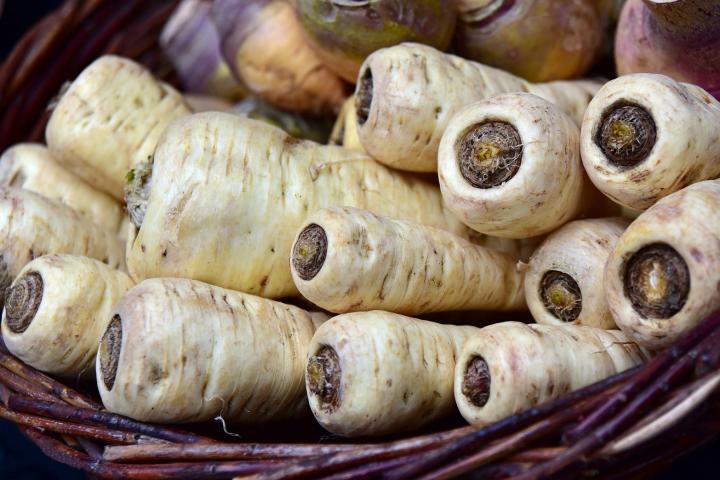Parsnips, popular with ancient Greeks and Romans, were brought over to the Americas with the first colonists. Like carrots, parsnips are biennials, but they are usually grown as an annual vegetable and taste best after being kissed by an autumn frost before harvest. Here’s how to plant, grow, and harvest parsnips in your garden!
About Parsnips
A relative of the carrot, parsnips are a super-hardy, cool-season crop that requires a long growing season and is best harvested after a few fall frosts. Parsnips are especially tasty in soups and stews, lending them a nutty, sweet flavor, but these root vegetables can also be enjoyed by themselves as a side dish. Plus, they are packed with nutrients, like potassium and vitamins B6 and C!
Note: Parsnip leaves contain a sap that may irritate the skin. When weeding around or harvesting parsnips, wearing long sleeves and gloves is recommended.
When to Plant Parsnips
- Parsnips need a long growing season, so sow seeds as soon as the soil is workable in the spring.
- Parsnip seeds will germinate in soil temperatures as low as 48°F (9°C), but warmer soil will speed up germination.
Preparing the Planting Site
- Plant in loose soil that drains well and is free of rocks. Clay or compacted soils can cause parsnip roots to be thin and misshapen.
- Make sure the area is clear of weeds.
- Loosen the soil to a depth of 12 to 15 inches and mix in a 2- to 4-inch layer of compost or aged manure for fertility.
How to Plant Parsnips
- Always sow fresh seed. Parsnip seeds do not store well and seeds that are more than a year old will have a reduced germination rate.
- Sow seeds directly in the garden.
- Be sure to keep soil moist while seeds are germinating.
- Sow 2-3 seeds per inch, 1/2-inch deep. Sow in rows 18 to 24 inches wide.
- Tip: Sow radish seeds in between your parsnip seedings. Radishes will grow quickly, marking the row and loosening the soil for the parsnips.
- Parsnips are slow to germinate. Seedlings typically emerge in 2 to 3 weeks—or longer in soil temperatures below 50°F (10°C).
- Tip: To speed up germination, give parsnip seeds a head start on wet paper towels indoors. Press the seeds into the paper towels, keep them in a warm place, and sow outdoors after the seeds develop little white roots.

How to Grow Parsnips
- Once seedlings are 2 to 3 inches tall, thin them so that they’re spaced 3 to 4 inches apart. To avoid disturbing the delicate roots of the remaining seedlings, simply snip off the tops of the ones you’re thinning—don’t pull them out.
- Always keep the beds free of weeds, especially when plants are young.
- Use row covers to deter pests.
- Parsnips need a fair amount of moisture to form healthy roots. Water during the summer if rainfall is less than 1 inch per week.
- As long as you started with good soil, fertilizing is likely not necessary. Excess nitrogen will encourage top growth instead of root growth.
- Once roots start to form, hill soil around the plants’ base to prevent the root’s shoulders from turning green.
- Note: Parsnip leaves contain a sap that may irritate the skin. When weeding around or harvesting parsnips, wearing long sleeves and gloves is recommended.
- Aphids
- Leaf Miners
- Carrot Rust Flies
- Parsnip Canker (all cultivars but ‘Tender and True’ are resistant to this)
Choose short-root varieties for soil that is shallow, heavy, and/or contains a lot of rocks.
- ‘All-American’: Tapered, 10- to 12-inch white roots; high sugar content; stores well
- ‘Harris Model’: Smooth, tapered, 10-inch white roots, free of side roots
- ‘Hollow Crown’: Mild, 12-inch white, fine-grain roots; flavor improves after frost
- ‘Kral Russian’: Heirloom; beet-shape root; good for shallow or heavy soil.
How to Harvest Parsnips
- Parsnips require a long growing season. They are typically ready to harvest 3 to 4 months after planting, depending on the variety.
- Harvest when roots are at least 1 inch in diameter.
- Leave your parsnips in the ground for a few frosts, but harvest before the ground freezes. When exposed to near-freezing temperatures for 2 to 4 weeks in the fall/early winter, the starch in the root changes into sugar, resulting in a strong, sweet, unique taste.
- If you leave them in the ground for the winter, cover them with a thick layer of mulch and harvest immediately after the ground thaws in the spring, before top growth starts. If a flower stalk develops, roots may turn woody.
How to Store Parsnips
- Before storing parsnips, trim foliage down to 2 to 3 inches.
- Store parsnips between 32 and 35°F (0 and 2°C), with a humidity of 90 to 95%.
- For longer-term storage (4 to 6 months), store roots in slightly damp sand or sawdust.
- Soft words butter no parsnips, but they won’t harden the heart of the cabbage either. –Irish proverb
Try roasting parsnips with carrots and potatoes.




